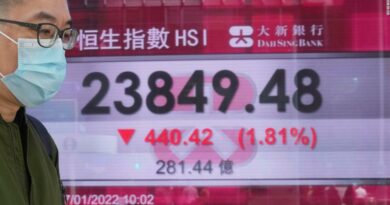Asian Markets Mostly Lower
Asian stock markets are mostly lower on Friday following the negative cues overnight from Wall Street as treasury yields spiked in reaction to the highly anticipated Federal Reserve Chair Jerome Powell’s remarks, which failed to calm concerns about higher interest rates and inflation. Surging crude oil prices is also weighing on the markets. Asian stocks closed lower on Thursday.
The Australian stock market is notably lower on Friday, extending losses from the previous session, with the benchmark S&P/ASX 200 falling below the 6,700 level as gains in energy stocks were more than offset by weakness among technology stocks.
The benchmark S&P/ASX 200 Index is losing 64.30 points or 0.95 percent to 6,696.40, after touching a low of 6,660.50 earlier. The broader All Ordinaries Index is lower by 77.90 points or 1.11 percent to 6,922.70. Australian stocks closed lower on Thursday.
The major miners are weak. Fortescue Metals is down almost 1 percent, Rio Tinto is declining almost 3 percent and BHP Group is losing nearly 2 percent.
Oil stocks are higher after crude oil prices increased overnight. Woodside Petroleum is adding more than 2 percent, Oil Search is gaining almost 3 percent and Santos is higher by more than 4 percent.
Among the big four banks, Westpac, National Australia Bank and Commonwealth Bank are all edging down below 0.6 percent, while ANZ Banking is edging up 0.3 percent.
Losses on the tech-heavy Nasdaq pulled down local peers, with Afterpay losing more than 5 percent and WiseTech Global declining more than 3 percent, while Appen is down almost 4 percent.
Gold miners are lower as gold prices hit a nine-month low. Evolution Mining is sliding more than 2 percent, while Newcrest Mining is down more than 1 percent. Northern Star Resources is declining nearly 2 percent.
In economic news, the latest survey from the Australian Industry Group showed that the services sector in Australia expanded in February, with a seasonally adjusted Performance of Service Index score of 58.8, the highest reading since June of 2018. That’s up from 54.3 in January and it remains above the boom-or-bust line of 50 that separates expansion from contraction.
In the currency market, the Aussie dollar is trading at $0.770 on Friday.
The Japanese stock market is sharply lower for a second straight session on Friday, with the benchmark Nikkei 225 treading below 28,500 levels, driven by continued selloff in technology shares. Investors are worried that rising bond yields in recent days could hurt high-growth companies reliant on easy borrowing.
Meanwhile, the Japanese government has extended the COVID-19 related state of emergency by two weeks for the Tokyo region to prevent a fresh wave of infections. The emergency was set to expire on Sunday.
The benchmark Nikkei 225 Index closed the morning session at 28,359.11, down 571.00 points or 1.97 percent to, after touching a low of 28,310.10 in early trades. Japanese shares closed lower on Thursday.
Market heavyweight SoftBank Group is losing almost 3 percent, while Fast Retailing is declining nearly 5 percent. Among automakers, Honda is losing almost 1percent and Toyota is lower by almost 2 percent.
In the tech space, Advantest is losing almost 4 percent and Tokyo Electron is declining nearly 5 percent. In the banking sector, Mitsubishi UFJ Financial is down 0.8 percent, while Sumitomo Mitsui Financial is edging down 0.3 percent.
The major exporters are mostly lower, with Mitsubishi Electric declining almost 1 percent, Canon down more than 3 percent and Sony losing more than 2 percent, while Panasonic is edging up 0.4 percent.
Among the other major gainers, Casio Computer is gaining more than 4 percent, while Citizen Watch and Sekisui House are rising more than 3 percent each. Inpex, Maruha Nichiro, AGC, Sumitomo Dainippon Pharma, Tokyo Electric Power, Mitsui E&S Holdings, Nippon Steel and Teijin are all up nearly 2 percent each.
Conversely, Hitachi Zosen is losing more than 10 percent, Pacific Metals is lower by more than 6 percent, Recruit Holdings is declining almost 6 percent and Sumitomo Reality is down almost 5 percent. Toho Zinc, Z Holdings, Sumco and Tokyo Electron are all losing more than 4 percent.
In economic news, Foreign Exchange Reserves in Japan decreased to $1,379.4 billion in February from $1,392.10 billion in January of 2021, according to the Ministry of Finance, Japan
In the currency market, the U.S. dollar is trading in the upper 107 yen-range on Friday.
Elsewhere in Asia, Hong Kong and South Korea are losing more than 1 percent each, while New Zealand, Taiwan, Indonesia, China and Singapore are all down between 0.3 and 0.7 percent. Malaysia is edging higher.
On Wall Street, stocks saw substantial volatility during trading on Thursday, with a sell-off seen in early afternoon trading resulting in a sharply lower close for the markets. With the steep drop on the day, the major averages extended the substantial move to the downside seen over the two previous sessions. The Dow and the S&P 500 slumped to their lowest closing levels in a month, while the tech-heavy Nasdaq plunged to a two-month closing low.
The major averages all posted steep losses on the day, although the Nasdaq underperformed its counterparts. The Nasdaq plummeted 274.28 points or 2.1 percent to 12,723.47, while the Dow tumbled 345.95 points or 1.1 percent to 30,924.14 and the S&P 500 dove 51.25 points or 1.3 percent to 3,768.47.
The major European markets also moved to the downside on Thursday. The U.K.’s FTSE 100 Index fell by 0.4 percent and the German DAX Index dipped by 0.2 percent, while the French CAC 40 Index ended the day nearly unchanged.
Crude oil futures moved sharply higher on Thursday, lifted by an announcement by the OPEC+ would keep production steady for now. West Texas Intermediate crude oil futures for April ended higher by $2.55 or about 4.2% at $63.83 a barrel, recovering well after early weakness.
Source: Read Full Article


